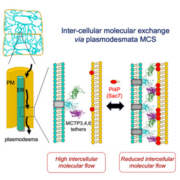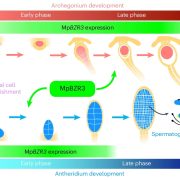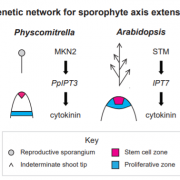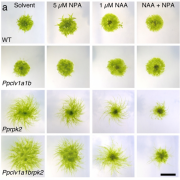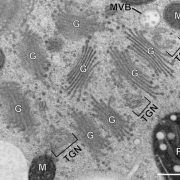Keeping Walls on Track
Schneider et al. explore how secondary cell walls are made. The Plant Cell 2017. https://doi.org/10.1105/tpc.17.00309
Background: Plant cells are surrounded by robust cell walls that function as dynamic extracellular skeletons and protect plants against their environment. The cell walls make up the bulk of biomass and are utilized in a range of industrial applications, including feed, food, fuel and construction material. Understanding how plants produce cell walls is therefore of great importance. Water-transporting xylem cells produce walls that are rich in cellulose (a polysaccharide) and lignin (composed of polyphenols). Strikingly, the walls of xylem cells are produced in intricate patterns, for example bands or spirals, that allow xylem cells to withstand internal negative pressure necessary to transport water. These patterns are thought to be directed by the intracellular cytoskeleton, in particular microtubules, that guide cellulose synthesis.
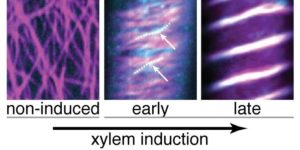
Connections between microtubule cytoskeleton and cellulose synthesizing proteins are needed for proper initiation of xylem vessel cell wall patterns. Panels show single cells in dark-grown seedling stems that express a fluorescently-tagged cellulose synthase (CESA; turquoise) that is active in xylem vessel formation and microtubule subunits (magenta). In the early phases the CESA trajectories do not align well with the microtubules (see dotted lines and arrows), but the tracks become aligned with the microtubules over time (the fluorescence signals coincide in late stage). We conclude that the link between the CESAs and microtubules is needed only during the early stages of vessel formation and that another molecular process re-aligns the CESAs and microtubules during xylem differentiation.
Question: The components of the xylem walls are well known, but how the patterning of these walls is achieved is not well understood. We therefore set out to investigate how these patterns are established and sustained during xylem development.
Findings: We used several complementary systems to address these questions, including Arabidopsis and rice plants. One of the key experimental set-ups was the use of a xylem-inducible seedling system where we could directly image the process of xylem wall patterning using confocal microscopy. To do this we introgressed fluorescently-tagged proteins, with a focus on cellulose synthesizing proteins and microtubule subunits, into the inducible system and imaged these during xylem development. We also studied how xylem development and wall patterning are affected by mutations that disturb the connection between the microtubules and the cellulose synthesizing proteins. We found that microtubules are needed to establish wall patterns during xylem development, but that once the patterns are established they can be maintained without much contribution of the microtubules.
Next steps: While our research contributes important new information about how cell wall patterns are controlled, it is not clear what is driving the microtubules to change their distribution from a relatively evenly distributed array before xylem onset to a banded or spiralling pattern once the development is induced. In addition, another type of xylem cell has reticulated wall patterns and so it will be very interesting to identify similarities and differences in how these two patterns come about.
Rene Schneider, Lu Tang, Edwin R Lampugnani, Sarah Barkwill, Rahul Lathe, Yi Zhang, Heather E. McFarlane, Edouard Pesquet, Totte Niittyla, Shawn D. Mansfield, Yihua Zhou, Staffan Persson. 2017. CSI1/POM2 steers xylem vessel wall patterning. Plant Cell https://doi.org/10.1105/tpc.17.00309



